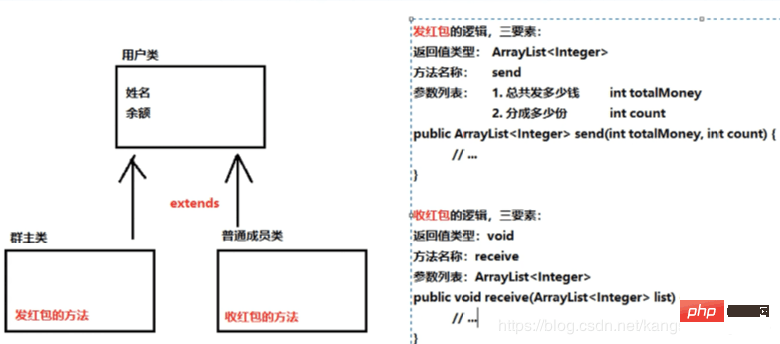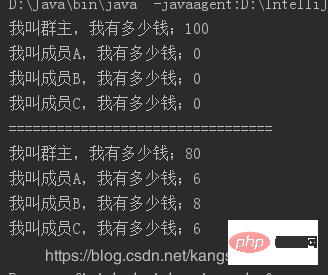Inheritance exercise of Java red envelope example

[Related learning recommendations: java basic tutorial]
Case:
Insert here Picture description
Case illustration:
is divided into three categories. One parent category puts the amount and name in the parent category. Then create two new classes, namely the group main class and the ordinary member class. The group leader class has a method for sending red envelopes, and the ordinary member class has a method for receiving red envelopes. That is to say, only the group leader can send red envelopes, and ordinary members can only receive red envelopes. 
Code implementation:
Parent class
package cn.itcast.day09.demo14;public class User {
private String name;//姓名
private int money;//余额
public User() {
}
public User(String name, int money) {
this.name = name;
this.money = money;
}
//显示余额
public void show(){
System.out.println("我叫"+name+",我有多少钱;"+money);
}
public String getName() {
return name;
}
public void setName(String name) {
this.name = name;
}
public int getMoney() {
return money;
}
public void setMoney(int money) {
this.money = money;
}}Group owner Class:
package cn.itcast.day09.demo14;import cn.itcast.day09.demo04.Arraylis;import java.util.ArrayList;public class Manager extends User {
public Manager(){
}
public Manager(String name, int money) {
super(name, money);
}
//发红包方法
public ArrayList<Integer> send(int totalMoney,int count){
//首先需要一个集合,用来存储若干个红包金额
ArrayList<Integer> redList=new ArrayList<>();
//首先看下群主自己有多少钱
int LeftMoney=super.getMoney();//获取群主当前余额
//判断群主余额是否充足
if(totalMoney>LeftMoney){
System.out.println("余额不足");
return redList;//返回空集合
}
//扣钱,更新余额。
//公式:最新余额=上次余额-发的钱
super.setMoney(LeftMoney-totalMoney);
//发红包需要平均拆分成为count份
int avg=totalMoney/count;
int mod=totalMoney %count;//余数,也就是零头
//下面把红包一个一个放到集合当中
for (int i = 0; i < count-1; i++) {
redList.add(avg);
//除不开的零头,抱在最后一个红包当中
/*if(i==count-1){
redList.add(avg+mod);
}*/
}
int last=(avg+mod);
//除不开的零头,抱在最后一个红包当中
redList.add(last);
return redList;
}}Common member class:
package cn.itcast.day09.demo14;import java.util.ArrayList;import java.util.Random;//普通成员public class Member extends User{
public Member() {
}
public Member(String name, int money) {
super(name, money);
}
//收红包的方法
public void recive(ArrayList<Integer> list){
//从多个红包当中随便抽取一个,给自己
//随机获取一个list集合当中的随机编号
int index=new Random().nextInt(list.size());
//根据索引,从集合当中删除,并且得到被删除的红包给自己。
int delta=list.remove(index);
//当前成员本来有多少钱
int money=super.getMoney();
//从新设置余额
super.setMoney(money+delta);
}}Client:
package cn.itcast.day09.demo14;import java.util.ArrayList;public class MainRedPacket {
public static void main(String[] args) {
Manager manager=new Manager("群主",100);
Member one=new Member("成员A",0);
Member two=new Member("成员B",0);
Member three=new Member("成员C",0);
manager.show();
one.show();
two.show();
three.show();
System.out.println("=================================");
ArrayList<Integer> redList=manager.send(20,3);
//三个普通成员收红包
one.recive(redList);
two.recive(redList);
three.recive(redList);
//群主最新余额
manager.show();
//成员最新余额
one.show();
two.show();
three.show();
}}Result

Related learning recommendations: Programming video
The above is the detailed content of Inheritance exercise of Java red envelope example. For more information, please follow other related articles on the PHP Chinese website!

Hot AI Tools

Undresser.AI Undress
AI-powered app for creating realistic nude photos

AI Clothes Remover
Online AI tool for removing clothes from photos.

Undress AI Tool
Undress images for free

Clothoff.io
AI clothes remover

Video Face Swap
Swap faces in any video effortlessly with our completely free AI face swap tool!

Hot Article

Hot Tools

Notepad++7.3.1
Easy-to-use and free code editor

SublimeText3 Chinese version
Chinese version, very easy to use

Zend Studio 13.0.1
Powerful PHP integrated development environment

Dreamweaver CS6
Visual web development tools

SublimeText3 Mac version
God-level code editing software (SublimeText3)

Hot Topics
 1387
1387
 52
52
 Perfect Number in Java
Aug 30, 2024 pm 04:28 PM
Perfect Number in Java
Aug 30, 2024 pm 04:28 PM
Guide to Perfect Number in Java. Here we discuss the Definition, How to check Perfect number in Java?, examples with code implementation.
 Weka in Java
Aug 30, 2024 pm 04:28 PM
Weka in Java
Aug 30, 2024 pm 04:28 PM
Guide to Weka in Java. Here we discuss the Introduction, how to use weka java, the type of platform, and advantages with examples.
 Smith Number in Java
Aug 30, 2024 pm 04:28 PM
Smith Number in Java
Aug 30, 2024 pm 04:28 PM
Guide to Smith Number in Java. Here we discuss the Definition, How to check smith number in Java? example with code implementation.
 Java Spring Interview Questions
Aug 30, 2024 pm 04:29 PM
Java Spring Interview Questions
Aug 30, 2024 pm 04:29 PM
In this article, we have kept the most asked Java Spring Interview Questions with their detailed answers. So that you can crack the interview.
 Break or return from Java 8 stream forEach?
Feb 07, 2025 pm 12:09 PM
Break or return from Java 8 stream forEach?
Feb 07, 2025 pm 12:09 PM
Java 8 introduces the Stream API, providing a powerful and expressive way to process data collections. However, a common question when using Stream is: How to break or return from a forEach operation? Traditional loops allow for early interruption or return, but Stream's forEach method does not directly support this method. This article will explain the reasons and explore alternative methods for implementing premature termination in Stream processing systems. Further reading: Java Stream API improvements Understand Stream forEach The forEach method is a terminal operation that performs one operation on each element in the Stream. Its design intention is
 TimeStamp to Date in Java
Aug 30, 2024 pm 04:28 PM
TimeStamp to Date in Java
Aug 30, 2024 pm 04:28 PM
Guide to TimeStamp to Date in Java. Here we also discuss the introduction and how to convert timestamp to date in java along with examples.
 Java Program to Find the Volume of Capsule
Feb 07, 2025 am 11:37 AM
Java Program to Find the Volume of Capsule
Feb 07, 2025 am 11:37 AM
Capsules are three-dimensional geometric figures, composed of a cylinder and a hemisphere at both ends. The volume of the capsule can be calculated by adding the volume of the cylinder and the volume of the hemisphere at both ends. This tutorial will discuss how to calculate the volume of a given capsule in Java using different methods. Capsule volume formula The formula for capsule volume is as follows: Capsule volume = Cylindrical volume Volume Two hemisphere volume in, r: The radius of the hemisphere. h: The height of the cylinder (excluding the hemisphere). Example 1 enter Radius = 5 units Height = 10 units Output Volume = 1570.8 cubic units explain Calculate volume using formula: Volume = π × r2 × h (4
 Explain the difference between self::, parent::, and static:: in PHP OOP.
Apr 09, 2025 am 12:04 AM
Explain the difference between self::, parent::, and static:: in PHP OOP.
Apr 09, 2025 am 12:04 AM
In PHPOOP, self:: refers to the current class, parent:: refers to the parent class, static:: is used for late static binding. 1.self:: is used for static method and constant calls, but does not support late static binding. 2.parent:: is used for subclasses to call parent class methods, and private methods cannot be accessed. 3.static:: supports late static binding, suitable for inheritance and polymorphism, but may affect the readability of the code.




